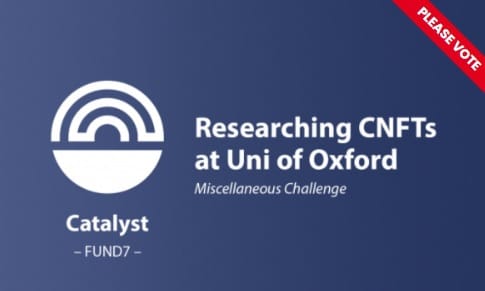Cardano NFTs (or CNFTs) have been gaining a lot of traction over the past year, even reaching prominent institutions like the University of Oxford.
We invited Eva from GINGR pool, who previously was on the Cardano SPO Column, to talk about a thesis for her Art History Master that she’s doing in the UK.
Summary
Cardano NFTs at University of Oxford

Hi Eva, welcome back to The Cryptonomist. Let’s first talk about Project Catalyst, what is it and how can it help your research?
Hi Patryk and thank you for having me again, much has changed since the last time!
Project Catalyst is the world’s biggest Decentralised Autonomous Organisation (DAO). It is also the tool through which holders of ADA (Cardano’s cryptocurrency) can actively be part of the governance and steer what is being built in the near future. Everyone with a registered wallet (containing a minimum of 500 ADA) can use their voting power to either up- or downvote proposals.
For Fund 7, I have submitted a Catalyst proposal called Researching CNFTs at Uni of Oxford (Miscellaneous Challenge). As the title implies, I am working on a thesis about Cardano NFTs at the University of Oxford. Getting funding for doing research is always difficult and crucial at the same time. In this case, it would allow me to dedicate even more time to this and other Cardano-related projects.
What is this research focusing on and what do you hope to achieve with it?
The core of my research is to study blockchain as a new art medium. Looking at the art that is being produced on it, the NFTs, allows me to draw conclusions about the medium as well. I’ll be using unsigned.algorithms as one case study to describe how art is intertwined with the blockchain as its medium. My main interest lies in projects that are created fully on-chain – Blockchain Native Art. The goal is also to locate NFTs in the broader context of art history; I am looking at art movements of the past 70 years (such as abstract art, digital art, but also performance art) and I’ll be analysing their influence on Blockchain Native Art.
Eventually, I will argue that the blockchain as an art medium is restructuring the ways how art is conceptualised, made and consumed. This is relevant as this change in art making represents the fundamental change that blockchain technology can bring to our societal structure in general.
While Cardano is research-based, the Humanities have been mostly neglected so far – leaving me in a very fortunate position to represent Cardano in humanistic research, namely in the field of art history. The University of Oxford has an excellent reputation and my goal is to establish a new research field.
More information about my research can be found on my website.
There are so many blockchains to choose from to mint NFTs, why does Cardano stand out for you?
There are various aspects about it, but the main reason for me is ideological. Cardano is using the Ouroboros protocol which relies on peer-reviewed research. Being affiliated with academia for such a long time, Cardano was very attractive to me from the very beginning when there was no NFT space yet. This thorough research is the reason why it is possible for Cardano to offer the most sustainable infrastructure and this is also what I wish to support.
Even though I am only involved in the CNFT space, I think NFT art bears immense artistic potential in general and great art can be found on other chains as well. But no gas fees and a high transaction volume are undoubtedly advantages Cardano has to offer, especially compared to the more mature Ethereum space.
Besides the usual JPEGs, what other use cases are there for NFTs? Can you give some examples?
There is an incredibly wide range of use cases that involve NFTs and I’ll focus on some that are related to art. In the traditional art market, tracing the chain of ownership (provenance), and thus having a guarantee for authenticity is highly important. NFTs inherently cover this use case. There are certain platforms that offer to connect physical artworks with NFTs.
Yifu Pedersen, as already mentioned previously, uses NFTs as a proof of ownership for their Cardano-themed jewellry collection. OriginThread has a similar concept. They are building a men’s fashion brand with the goal to connect people with the entire story of their garments. The fashion industry has been under critique since a while due to illucid production conditions and unfair price policies. Connecting garments with NFTs makes it possible to have all information transparently stored on-chain and trace the piece back to its origin.
As a last example, I’d like to talk about Non-Fungible Visualizations (NFVs) which serve as a second case study in my research. I work with Patrick from programmable.art on this new type of NFT which consists of a dynamic data source (can be blockchain data but also external data such as weather or health data) and its visualisation which is minted on Cardano. In short, an NFT that is changing whenever the data source is changing. On one hand, it is possible to visualise information in a way that is much more understandable and tangible; data that is telling a story (the Epoch Clock is displaying the epoch time for example). On the other hand, these visualisations can be turned into abstract art; information that is translated into pure aesthetic expression. The possibilities are (almost) endless! This means NFVs are the combination of ownership, information and aesthetics – the art of data.
Thank you kindly for your time, do you have any final thoughts to share? Where can people find you and the Catalyst proposal
Everyone who wants to connect can find me on Twitter or Discord, I am always glad to hear others stories! Researching CNFTs, building new things on Cardano and exploring this space together with other people are incredibly powerful tools to me to do something meaningful. We are building our future – which feels amazing.
I am grateful for every support on my way. Staking with GINGR pool or voting for my Catalyst proposal is the easiest way to do so 🙂
Thank you!




